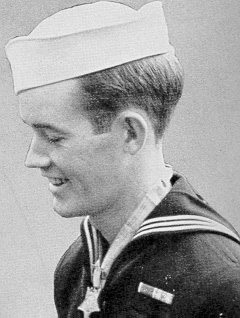WAHLEN-GEORGE
GEORGE EDWARD WAHLEN

PHM2/MAJ


Despite the prominence of its name in the lexicon of American military history, Iwo Jima is a very small island located some 760 miles south of Tokyo. Both Japanese and American strategic planners recognized its strategic importance and sought to exploit it. The Japanese used aircraft flying out of its airfields to intercept American B-29 bombers on their transit to and from Japan and to attack U.S. forces located in the Marianas. The United States planned on using the island's airfields as emergency landing strips for crippled American bombers if it could be wrested from Japanese control.
Realizing the importance of Iwo Jima, the Japanese garrisoned the island with more than 21,000 soldiers and began building an extensive system of fortifications throughout the island. To counter this vast network of tunnels, minefields, fixed artillery, and machine gun emplacements, the Navy commenced the heaviest naval bombardment of the war on February 16, 1945. Over the next three days, the Navy fired over 22,000 5-inch and larger projectiles into the island.
The amphibious assault began at 9 a.m. on February 19, 1945. Despite the heavy pre-assault bombardment, the Marines had a hard time getting off the beach. The 26th Marines, as part of the reserve force, did not come ashore until the evening of February 19. On February 22, they relieved the 27th Marines and continued the attack toward the northeast.
As the Marines drove north across terrain mottled with gouges made by artillery and mortar shells, they faced a torrent of artillery fire directed at them from Hill 362B, located north of an unfinished airfield. Artillery fire from Hill 362B threatened the flanks of the Marine units driving eastward and had to be stopped. The 26th Marines were ordered to take Hill 362B on March 3, 1945, a day famous in the annals of 5th Division history, because five unit members earned the Medal of Honor that day. One of those men what PHM2 Wahlen, a Navy corpsman attached to the 26th Marines. Wahlen served his comrades faithfully throughout the battle of Iwo Jima. Despite being wounded on two separate occasions, he refused medical evacuation because he felt his buddies needed him.
The 26th Marines began their assault on Hill 362B at 7:45 a.m. on March 3. As the regiment moved forward, it encountered fierce resistance from the Japanese defenders. The terrain was sharply cut by gorges and jutting outcrops of rocks, which reduced the fighting to hand-to-hand combat using rifles, grenades, bazookas, and flamethrowers. Once again, Wahlen operated at the forefront of the battle, providing aid to his comrades throughout the day. His medical supplies had almost run dry when he was wounded for the third time in six days. Despite the seriousness of his own wounds, he crawled more than 50 yards to assist another wounded Marine. There, too weak to continue, Wahlen collapsed in a pool of his own blood. A half-hour later, members of his unit were able to reach him and drag him back to safety. Three months later Wahlen was awarded the Medal of Honor for his courageous actions on that day.
- taken from Honor, Courage and Commitment: United States Naval Reserve Medal of Honor Recipients, Naval Historical Center

